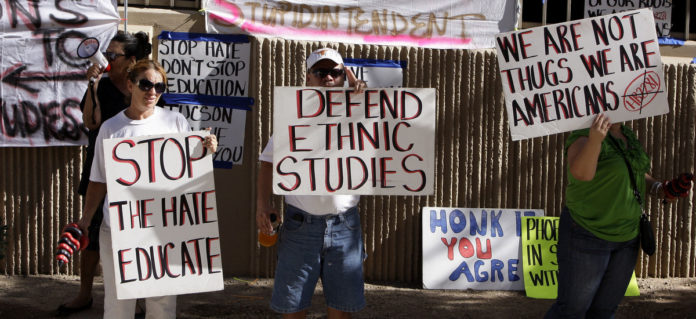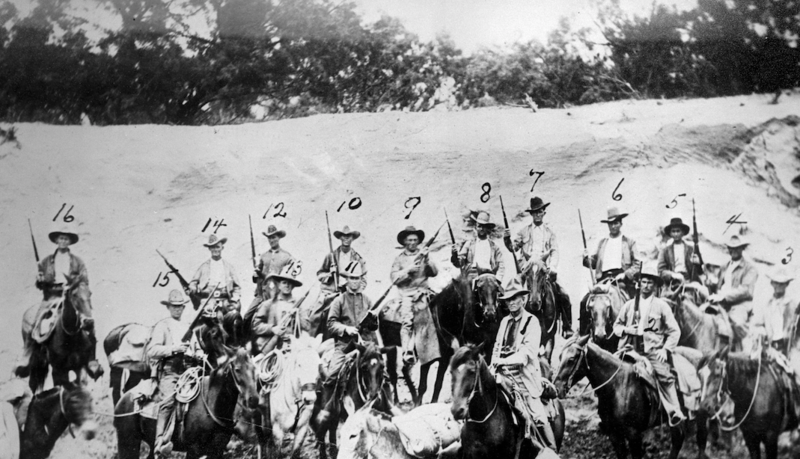
It’s hard to ignore the constant social injustices and hate-fueled harm being inflicted upon Latinos. It’s all over your newsfeed. It’s happening at the border. It’s causing devastation and pain from coast to coast. It’s hurting people you know and love in your own backyard. Discrimination against Latinos is happening as far up as the White House, without own president spouting racist, offensive, hurtful (and false!) remarks about Latino immigrants in this country. And thanks to his hateful rhetoric we see this discrimination trickling down to a newly emboldened group of white nationalists on a mission to rid the U.S. of any and all outsiders, especially Hispanics.
It’s 2019, and it’s shameful to even have to speak these words, but Latinos are under attack. It’s a scary time to be a minority, and in many places across the nation, it’s a really terrifying time to be a Latino.
The fact that Latinos are being targeted and the fact that many people feel they are being hunted in their own country is horrific enough as it is, but it’s exponentially more devastating and frustrating when you consider that this is not the first time that discrimination against Latinos has occurred in the U.S. Far from it. As with so many other minorities (blacks, Jews, Asians, Muslims…), Latinos have been singled out for decades. The only difference is that now it’s happening at a Wal-Mart…and at our border…and on social media. And arguably one of the worst differences — such blatant racist attacks and hate crimes are not being condemned, punished or stopped by our country’s administration. On the contrary, the administration is actually enabling this behavior. Oftentimes reports of anti-Latino hate crimes are met with shrugs from a president who has made it his mission to rid this country of “dangerous” immigrants and “criminals” coming across the border.

There’s no polite way to put this; Latinos are under assault. But it’s not new. They have always been under attack. The resentment of Latinos and fear of anyone who is different has been present for centuries, since the days of our founding fathers. But recently these racist thoughts and the violent actions that result are actually fueled by ignorance, bigotry and dangerously divisive rhetoric from President Trump, the leader who is supposed to unite the country and inspire peace and acceptance.
As difficult as it can be to discuss, and as devastating as it is that we are even here, talking about hate crimes, deadly xenophobia and homegrown terrorism, this discussion is vital. We cannot ignore what is happening, and knowledge is power. The more we know about the ways that Latinos have been marginalized and attacked in the past, the more equipped we will be to handle this same form of racism today. And hopefully, this will be the last time we had this conversation.
So let’s start at the beginning
A Brief History of Racism Against Latinos in the U.S.
Prejudice against Latinos goes back (all the way back) to the birth of our nation, shortly after the drafting of the Declaration of Independence in the late 1700s. Thomas Jefferson wanted to take over Latin America “piece by piece” and John Adams wanted nothing to do with the people of Latin America, who he considered to be ignorant and blindly devoted to priests over royalty. The hatred and bigotry wasn’t just reserved for Latin Americans, but also for the Spanish, a hate inherited from the British dating back long before America’s independence. In the 19th century the U.S. began taking over land to the south, seizing formerly Mexican lands that are now what we know to be Texas, Arizona, New Mexico, Colorado, Utah, Nevada and California. The Mexican–American War, which took place between 1846-1848, resulted in the United States’ acquisition of more than 500,000 square miles of Mexican territory extending westward from the Rio Grande to the Pacific Ocean. The Treaty of Guadalupe Hidalgo in 1848, which marked the end of the Mexican-American War, handed 55 percent of Mexico’s territory to the United States. But as America acquired those lands (and the people who live there), the mission was to spread American superiority to the world, not to incorporate and embrace the cultures of the people impacted by our expansion. The negative opinion towards the indigenous population was present then and persistent in the years to come.

983/112 R-447-1, TEXAS DEPARTMENT OF PUBLIC SAFETY PHOTOGRAPHS. ARCHIVES AND INFORMATION SERVICES DIVISION, TEXAS STATE LIBRARY AND ARCHIVES COMMISSION.
Later, in 1918, during the Porvenir Massacre, fifteen Mexicans and Mexican-Americans were murdered by a group of white men who were Texas Rangers, U.S. soldiers, and local vigilantes. The attack was justified by falsely labeling the Mexican American families as “criminals” (sound familiar?), but in reality this was just a small piece of a series of Mexican-American lynchings during the late 19th and early 20th century across the US. This single event was a part of a sweeping effort to assert white economic control of Texas, according to Monica Muñoz Martinez, a professor of American studies at Brown University and a founding member of Refusing to Forget, a not-for-profit organization that advocates for public reckoning with racial violence in Texas. “Historians estimate that hundreds of Mexican Americans and Mexican nationals were murdered between 1910 and 1920, in Texas alone,” Martinez said in The Guardian.
Later, in the mid-1900s, racial discrimination and segregation were still powerful forces, brought about by (or strengthened by) the chaos and insecurity prevalent during World War II. The cultural shift in the country led to a state of social anxiety, according to Eduardo Pagán, a history professor at Arizona State University. In June of 1943, that discrimination led to ten days of violence and rioting against Mexican-Americans in Los Angeles, called the Zoot Suit Riots. During these riots Mexican-Americans were targeted and pulled out of their homes and attacked because of their ethnicity, and more specifically because of what they were wearing (oversized, wide-legged trousers and long coats, called zoot suits). The attacks were not the only instance, or the first occurrence, of racial discrimination against Latinos, but those long-held resentments and racism were certainly on full display during these events.
In addition, for years there has been incessant violence against migrants and refugees crossing the border. Over the past two decades upwards of 7,000 people have lost their lives while attempting to cross the border, many of them coming from Mexico or Central America. “There are federal policies that have led to mass death at the border,” Martinez said. “That is a tremendous loss of life that the American public has largely ignored.”
And we can’t forget about individual attacks, fueled by hate and racism against Latinos across the country. Many of these anti-Latino attacks are fueled by anti-immigration policies, or the irrational fear that the government isn’t doing enough to stop immigration, so people take matters into their own hands and use violence to make their mission clear: they do not want Latinos in this country.
And that racism was only perpetuated by local politicians and the media, who falsely represented Hispanics as violent people and a threat to our nation, regardless of citizenship. If you think this sounds all too familiar and frighteningly similar to what is happening today, you’re not wrong…
Not Much has Changed in 2019
That was then, and this is now. And sadly, the state of the world and the endless social justices imposed on Latinos is not all that different.
We’ve seen the news reports. We’ve heard the hateful rants of the president. We see devastating images of families being torn apart, of migrant children being detained and separated from their families, of innocent people being targeted during ICE raids, of hard-working Latin American people being treated with indignities and being denied their right to seek asylum in the U.S. It’s horrific. But sadly, it’s all too familiar for anyone who has been paying attention.
A 2018 FBI report shows that since Trump was elected president hate crimes against Latinos have increased, and in 2017 alone such racist-fueled crimes grew by 24% in 2017.
The most recent attack at a Wal-Mart in El Paso, Texas that left 22 dead is just further proof of what many of us already knew: that discrimination against Latinos is not only still present, but that the flame of hate has recently been reignited by our administration and the current immigration debate that is flooding our newsfeed.
The El Paso shooter had a very clear motive, to target Latinos. He went far out of his way to plan his attack in a city and a community that is heavily Hispanic, with over 80% Latinos, mainly of Mexican background. Prior to the attack, he posted a hate-filled manifesto expressing anti-Hispanic and anti-immigrant sentiments, while also praising President Trump for his efforts to build a wall.
Just this week the Trump administration announced a plan to replace a decades-old agreement that limited how long undocumented families could be detained. The new proposal would allow undocumented families to be detained together indefinitely, in a hope that this new policy would discourage migrants from coming to the U.S.
Over and over again, Latinos are being targeted, discriminated against, and have paid a deadly price for the hateful rhetoric and racism that has been present and continues to exist for centuries. But perhaps most dangerous, is that many people do not realize this fact. They don’t know about the history of anti-Latino violence in this country, and they certainly are not aware that we are essentially witnessing history repeating itself again (and again). What we don’t know about the past just may be one of our biggest obstacles in fighting hate and working towards a better future. Considering the fact that Latinos in the United States now number 56.5 million, and it is estimated that by 2050 Hispanics will account for a third of this country’s residents, it’s more imperative than ever that we stand up for what is right, and the first step is to understand the history behind discrimination against Latinos and immigrants.
How We Can Be The Change For Latinos
While it’s a disgrace that discrimination against Latinos has been going on for decades and that this racism is still prevalent in American society today, here’s the harsh truth: nothing changes if nothing changes. If we as a country don’t take steps to end this discriminatory behavior and put a stop to the spread of false (and damaging) information about the Latino community, then nothing will ever change in terms of how the minority community is treated. In order for there to ever be a change, we have to BE the change. We need to take our anger and outrage and channel those emotions and frustration and turn them into action. We need to seek opportunities to speak out. We need to rise up to the task of righting the wrongs in the world. We need to stand up for what is just and we need to not be afraid to challenge those people who are a part of the problem (cough, our current administration, cough).
Countless grassroots organizations are mobilizing to raise awareness of the hardships faced by Latinos and immigrants. From defending the rights of migrants at the border to supporting Latino students and Dreamers, people are taking action. In addition, progressive politicians are using their voices and their positions of influence to fight for issues that are crucial to not only the Latino community but also the country and the world at large. And we all need to do the same.
In order to break the cycle and put an end to discrimination against Latinos once and for all, we need to prepare to get out of your comfort zone. In order to make change happen and to create an America that accepts everyone and is great for ALL Americans, not just the white Americans, we need to be willing to have the tough conversations. We need to address the difficult topics and the harsh realities of the past and present in order to create a better future. The first step is getting educated about the history of discrimination against Latinos. The next step is to get educated about what is happening today and wake up to the realities faced by minorities and immigrants daily in this country. And then we need to take action.
If you’re ready to contribute to the change movement, start local. Look into ways to get involved in your community. Attend rallies or marches. Organize groups to meet and discuss issues and injustices impacting Latinos in this country. Talk to your friends and relatives. Talk to local business owners. Talk to your children. If you see something, say something. If you witness unfair treatment or discrimination against Latinos, don’t just turn a blind eye and assume it won’t happen again or it won’t affect you. Speak out. Get involved. Write your own narrative and combat the constant stream of negative that surrounds the terms “Latino” and “immigrant.” Show support. While it might seem like these are small steps, remember that tiny actions from millions of do-gooders with good intentions can change the world. And if we don’t take those steps, small or large, to influence change, then change will never happen and our children (and their children…) will be having this same conversation in the future. Change starts now, and it starts with all of us.
For Image credit or remove please email for immediate removal - info@belatina.com






































